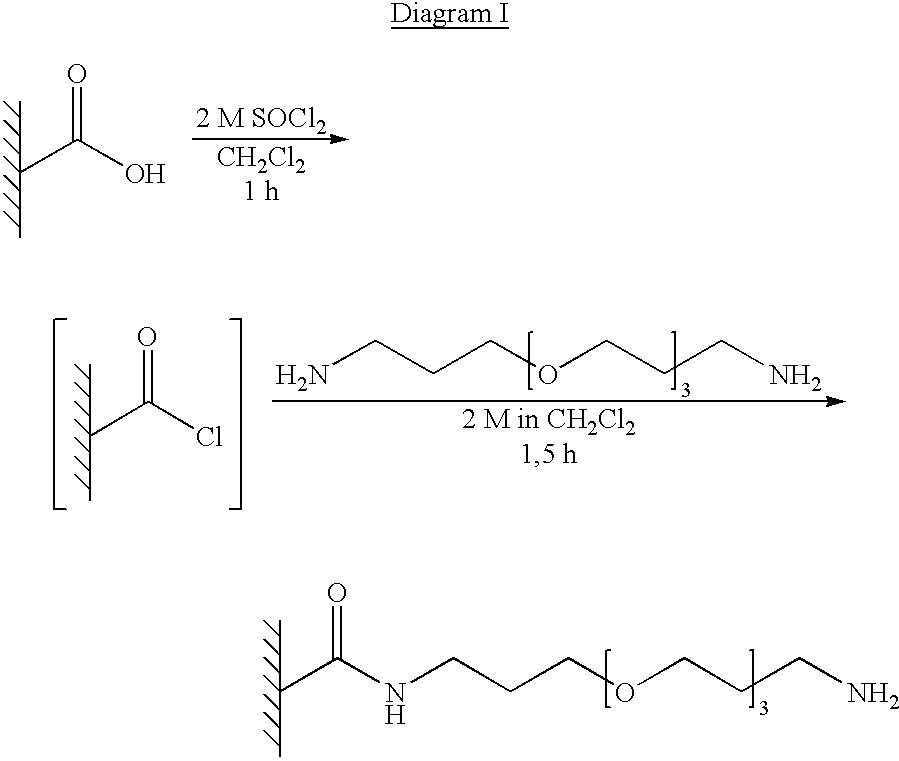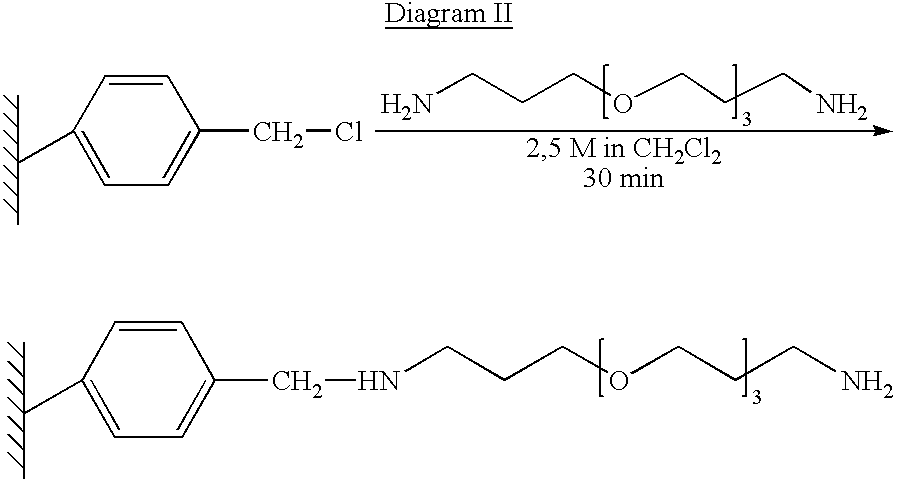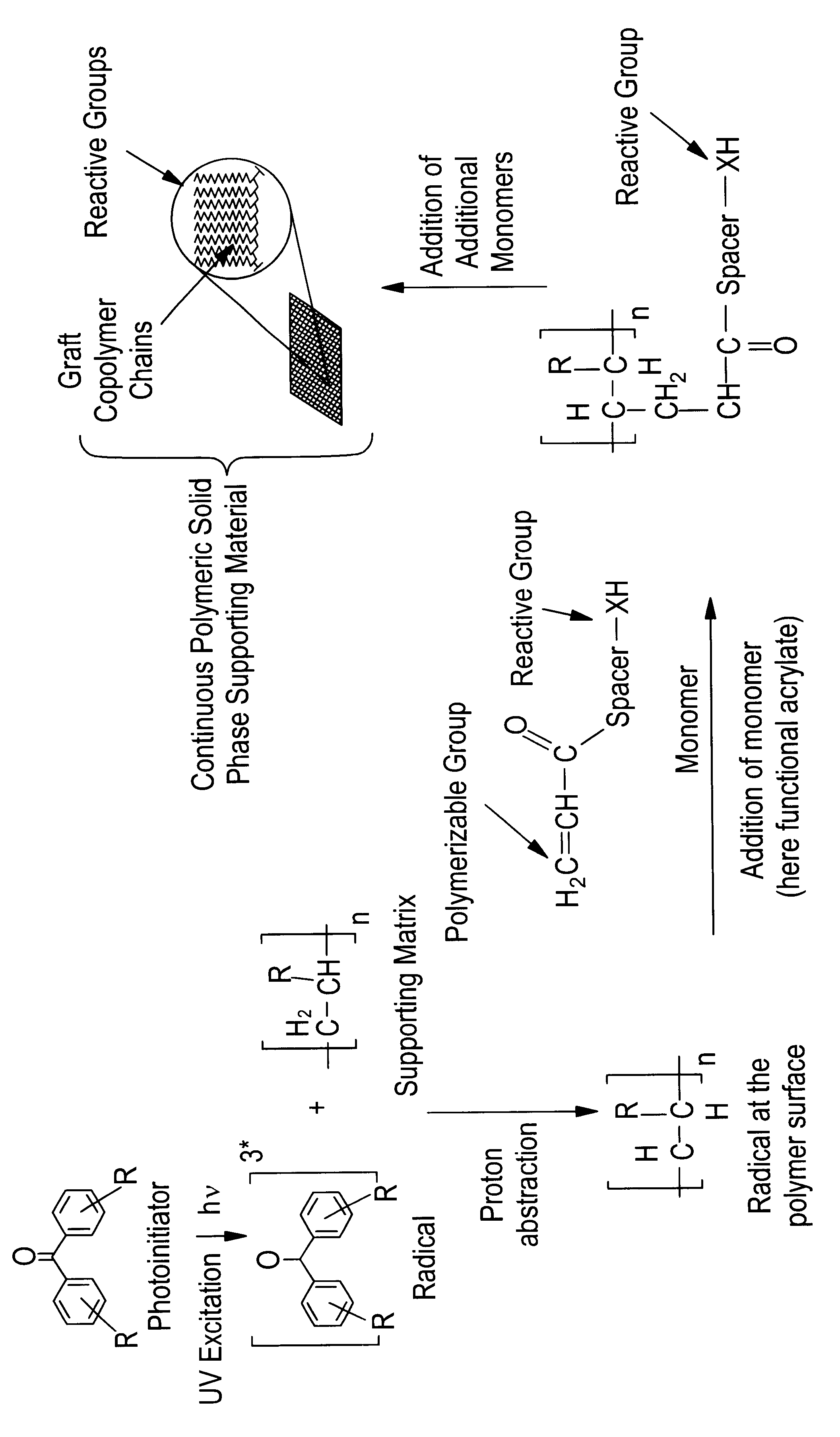Method for the parallel and combinatory synthesis of compounds bound to a continuous polymeric solid phase supporting material
a solid phase supporting material and compound technology, applied in the field of parallel, can solve the problems of limiting the variety of possible reactions, selective or complete reactions cannot be achieved, and the technology has been previously limited
- Summary
- Abstract
- Description
- Claims
- Application Information
AI Technical Summary
Benefits of technology
Problems solved by technology
Method used
Image
Examples
examples of embodiments
Example 1
Synthesis of Continuous Polymeric Solid Phase Supporting Materials--Hydroxy-PEG-ester-PP Membranes with Various Spacer Lengths--Under Laboratory Conditions
A PP membrane (Accurel 2E, Akzo; nom. pore diameter d.sub.p =0.2 .mu.m, layer thickness 150 .mu.m; d=80 mm) is equilibrated by shaking for 2 h with a 100 mM solution of benzophenone (BP) in methanol. The membrane is removed from the solution and the surface is rapidly dried in air without de-wetting the inside of the pores. After this, the membrane is placed in a Petri dish (d=90 mm) on a filter paper impregnated with a part of the monomer solution (approximately 5 ml), attached with a glass ring (d=80 mm) and immediately overlayered with the remainder of the polymerization solution (a total of 20 ml of 50 g / l of PEGMA 306 or 78.5 g / l of PEGMA 526, each in water saturated with BP. The monomers--PEG methacryalates, wherein the number describes the average molecular weight--are products of Polysciences Europe GmbH, Eppelhei...
example 2
Synthesis of Continuous Polymeric Solid Phase Supporting Materials--Carboxyl-PP or Carboxyl-polyethylene (PE) Membranes--Under Laboratory Conditions
A PP (Accurel 2E, Akzo; d.sub.p =0.2 .mu.m, layer thickness of 150 .mu.m) or PE membrane (Celgard 2500, Hoechst-Celanese, d.sub.p =0.2 .mu.m, layer thickness of 25 .mu.m) with a diameter of d=80 mm is equilibrated while shaking for 2 h with a 100 mM solution of BP in methanol. The membrane is removed from the solution and the surface is rapidly dried in air without de-wetting the inside of the pores. After this, the membrane is placed in a Petri dish (d=90 mm) on a filter paper impregnated with a portion of the monomer solution (approximately 5 ml), attached with a glass ring (d=80 mm) and immediately overlayered with the remainder of the monomer solution (a total of 20 ml of 10 g / l acrylic acid, AA, in water saturated with BP). The Petri dish is placed in a reactor, which is then sealed with a UV filter glass cover (cut-off 310 nm) and ...
example 3
Synthesis of Continuous Polymeric Solid Phase Supporting Materials--Hydroxy-amide-PP Membranes--Under Laboratory Conditions
A PP membrane (Accurel 2E, Aczo; d.sub.p =0.2 .mu.m) with a diameter of d=80 mm is equilibrated with a 100 mM solution of BP in acetone for 2 h while shaking. The membrane is removed from the solution and the surface is rapidly dried in air without dewetting the inside of the pores. After this, the membrane is placed in a Petri dish (d=90 mm) on a filter paper impregnated with a portion of the polymerization solution, (approximately 5 ml), attached with a glass ring (d=80 mm) and immediately overlayered with the remainder of the polymerization solution (a total of 20 ml of 40 g / l of 2-hydroxypropylmethacrylamide, 2 HPMAm, in water saturated with BP; monomer of Polysciences). The Petri dish is placed in a reactor which is sealed with a UV filter glass cover (cut-off 310 nm) and is flushed with nitrogen for at least 30 min. Subsequently--still under nitrogen flush...
PUM
| Property | Measurement | Unit |
|---|---|---|
| pore size | aaaaa | aaaaa |
| pore size | aaaaa | aaaaa |
| thickness | aaaaa | aaaaa |
Abstract
Description
Claims
Application Information
 Login to View More
Login to View More - R&D
- Intellectual Property
- Life Sciences
- Materials
- Tech Scout
- Unparalleled Data Quality
- Higher Quality Content
- 60% Fewer Hallucinations
Browse by: Latest US Patents, China's latest patents, Technical Efficacy Thesaurus, Application Domain, Technology Topic, Popular Technical Reports.
© 2025 PatSnap. All rights reserved.Legal|Privacy policy|Modern Slavery Act Transparency Statement|Sitemap|About US| Contact US: help@patsnap.com



